Classroom Environment Guide
Procedures
This is an example of what the Smart Board would look like each morning:

This is an example of what the Smart Board would look like each afternoon:
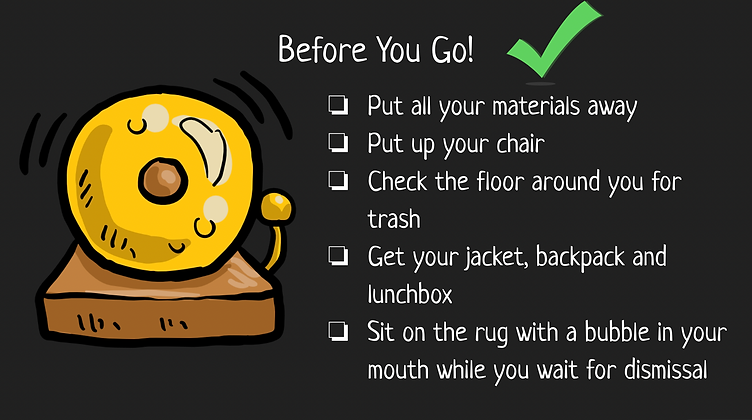
Lining Up and Walking in the Halls
Within my classroom, I would make use of line-up dot spots which I would just put on the ground where I want the students to line up. The students would be called up table by table and asked to stand with one student per one spot with a bubble in their mouths. The “bubble” is just them puffing out their cheeks to make it look like they’re holding a bubble. The students would be asked to keep their bubbles in their mouths as we walk down the hallway to keep the noise level at a minimum. The general line up rules would be included in the classroom set of rules which are also visibly displayed in the classroom. These rules and expectations will also be gone over during the first day of school so students know how they are expected to behave. On the first day of school, I would model this routine for them and have them practice it a few times so they understand what is being asked of them. I would also show them how to put a bubble in their mouths if they have never heard of that. This way, the students will know what to do whenever the class has to line up to go somewhere. This connects to the studies of Linda Albert where she emphasizes the importance of students and teachers working together to help combat student’s misbehavior. The teacher needs to exemplify and enforce the classroom rules and the students should do their part to try to follow the rules.
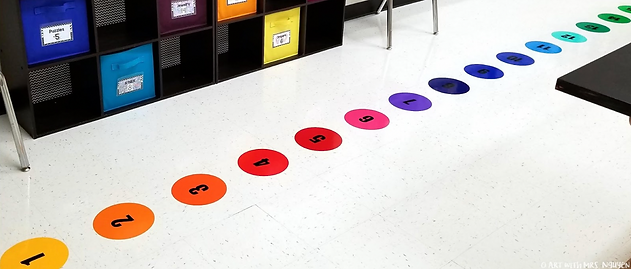
Entering the Classroom
Outside my classroom on the wall will be a poster with 4 options shown to the student before they walk in the door. The poster will have a picture of two hands forming a high five, someone giving someone else a hug, someone dancing, and a mouth open as if it were speaking. The student will point to which picture they want to exemplify as they walk into the classroom. I will be standing at the door waiting to greet each student and comply with each of their decisions. The students will come up to the door one by one and line up waiting to greet the teacher. Each student will point to a picture and complete the action. For example, if a student walks up to the door and points at the high five picture, the teacher will high five the student and say good morning as they walk through the door. On the first day of school I would stand outside the door and explain to each student what the poster means. As each student approaches the door, I would ask them if they prefer to high five, hug, dance, or simply say hello that morning. When they perform the task I will explain that this will be the routine every morning and they can decide a different greeting every day! This implementation of the morning greetings between the teacher and each individual student enhances the relationships the teacher has with the students. The face to face interaction is a great way to start the day as students may need an introduction to the classroom each day to fully get in the school mindset. This connects to William Glasser’s theories where he explores the five basic needs for students which includes their power, freedom, fun, belonging, and survival. He also emphasizes the fact that friendships are a valuable part of learning. By having this initial face-to-face time with their teacher first thing in the morning, the relationship between teacher and student grows each day as they greet each other and start the day alongside one another. This poster implementation also gives students the freedom and power to choose however they want to start their day. By giving the students a choice, they feel in control of the rest of their day and enter the classroom with a positive attitude and have fun greeting the teacher!
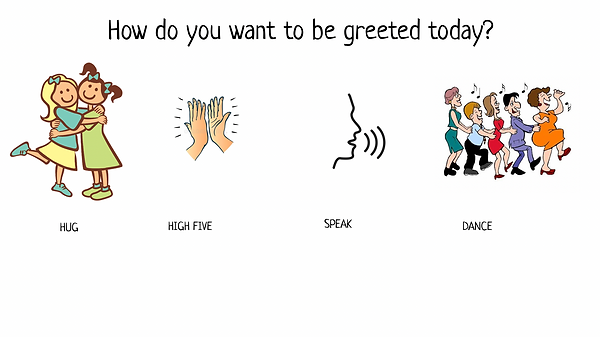
Classroom Jobs
In the front of the classroom would be a chart on a white board containing each student jobs available, a spot for the date at the top, and a space for a student’s name next to or under each job. Every morning before the students get to class, I would assign a job to a different student. I would rotate jobs so each student received a job at one point before repeating. A part of the student’s morning routine checklist is to check if they have a specific job that morning or not, and to complete the assigned job if they do. Examples of job titles that could be assigned could include the weather, the white board specials, the line leader/caboose, the attendance runner, or the calendar helper. I would communicate this to students on the first day of school during our first morning meeting. While I go through the daily activities such as going over the calendar and the weather, I will exemplify how to complete the job and verbally tell the students they will be expected to take turns to complete these jobs. I will show them the white board that will have different students’ names on it every day and go through every job and it’s expectations. Students will be excited about their new responsibility in the classroom! Jacob Kounin emphasizes the aspect of student responsibility and accountability within his theories and that is exactly what assigning classroom jobs does. By giving each student something to do in the morning that the whole class is dependent on, it gives them responsibility within the classroom and holds the students accountable for their actions.
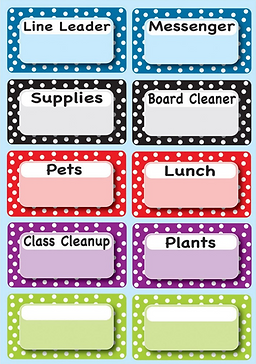
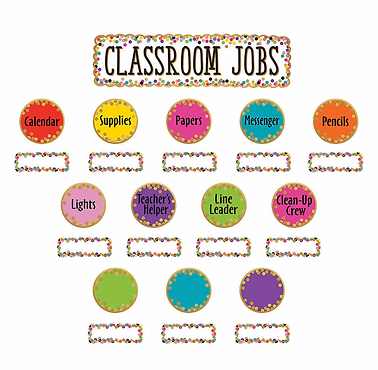
Information for Absent Students
I will create a sheet for absent students to utilize the day after they come back to receive the information, content, and materials they missed while they were absent. I will keep a stack of these printed sheets in a bin on my desk so students can grab them first thing when they come back to the classroom. It will be the student’s job to go through the sections of the sheet which will contain different subjects and ask their peers what they had for homework. After they have gathered their peer’s input, the student will bring the sheet to me and I will double check the homework they wrote down as well as add anything they had missed. I will also give the absent student any materials they missed if need be. I will explain this process to the students as a part of the morning meeting on the first day. I would show

the students where the sheets are located in the classroom and explain that they are responsible for trying to fill it out when they get back into the classroom. I will assure the students that they will be giving the absent sheet to me to double check and fill in any missing information if their classmates forgot to tell them something. I will also remind the students as they start to miss school days of the routine as well, since it would be their first time having to think about it since the first day’s morning meeting. Towards the end of the first few months the students should know what to do. This procedure and routine places all responsibility on the student that was absent. That student must retrieve an absentee form from the teacher’s desk and go around the class to ask their peers what they had for homework the day they were not there and fill it in. This process relies on the student to be completed and emphasizes Jacob Kounin’s theory of student accountability. This holds students accountable to be paying attention in the morning and trying to see what they missed the days they were absent. Giving students this responsibility helps them become more independent in the classroom and take their learning into their own hands.
Out-of-Class
At the front of the room will be a clipboard with a hall pass sign out sheet. Students will utilize this hall pass if they need to go to the bathroom, go to the water fountain, or leave the classroom for any reason. There will be 1 of 3 hall passes the students can take when they sign them out. If a student must leave the classroom, they will first ask the teacher, then sign out the hall pass on the sheet on the clipboard. The sheet asks the students to write down their name, the time they leave, and their reason for leaving. Once the student completes these steps, they may take a hall pass and leave the room. I would once again explain this process during the first morning meeting on the first day of school. I would also reiterate the process when students begin to need to leave

the classroom. For the first few weeks of school, I will go over this procedure with each student who asks to leave so they know what is expected of them and how they should go about this routine practice. This also connects to Jacob Kounin’s student accountability and responsibility as it allows students the freedom to leave the classroom. By implementing this system, this puts the responsibility on the student to first ask the teacher permission to leave the room, then the responsibility to fill out the sheet in the front of the room and complete whatever task they need to do outside the classroom.